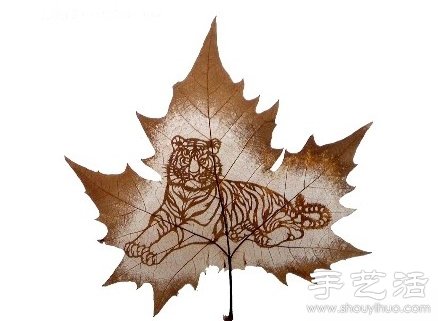
Leaf vein painting is a unique folk painting art that skillfully uses the graceful shapes and natural textures of different leaves to paint traditional Chinese landscapes, figures, flowers and birds on natural leaves, harmoniously blending the colorful pictures. Integrated with the natural beauty of leaves, it creates a unique, graceful and natural artistic realm, giving people the enjoyment of beauty.
The production process of leaf vein paintings mainly includes eight steps: material selection, fermentation, rinsing, bleaching, drying, ironing, production and mounting.
1 Selection of materials
The selection of raw leaves includes two aspects. One is what tree species to choose, and the other is what conditions the leaves themselves need to meet.
What we chose is the leaves of Huangjue. We first picked out some defective leaves, leaving only some leaves with beautiful and neat shapes, even veins and full texture. After selection, you can proceed directly to fermentation.
2 Fermentation
Fermentation simply means causing the mesophyll of the leaves to rot and fall off. First, put the selected leaves into the bucket crosswise. It must be laid evenly and flatly. Also note that the leaves should not be too full to avoid fermentation and expansion, filling the entire bucket. Put in a few floor tiles and press them flat, so that the leaves below are evenly stressed. After pressing, start to pour water. Generally, the water should be about 10cm above the height of the leaves. It is required to be placed in a sealed manner and the temperature is required to be maintained between 13-18 degrees Celsius. It can be opened in about 3 months. Taking out the fermented leaves, we see that the mesophyll has basically been fermented away, leaving only the vein network. Leaves that meet these requirements can be rinsed.
3 Rinse
Rinsing is mainly to clean the mesophyll and some impurities attached to the surface of the leaves. The most critical part of flushing is the water pipe nozzle. We choose a small-mouth water pipe here, which can reduce the water pressure. Use a homemade knife to scrape off the large pieces of mesophyll attached to the fermented leaves, and then rinse them. After the leaves are rinsed, they need to be bleached.
4 Bleaching
Bleaching mainly includes three steps: first bleaching, second bleaching and third bleaching.
First of all, let’s take a look at what’s going on with Yipiao. Prepare a large container. Here we choose the same plastic bucket as for fermentation.Fill the surface with water and pour 1 liter of bleaching powder solution. The bleaching powder solution here is directly blended with water. The ratio of water to bleaching powder is about 75:1. After mixing well, add the leaves. After leaving it at room temperature for about 10 days, the second bleaching can be carried out. The second bleaching is to directly take out the leaves from the first bleaching and soak them in clean water for 7 days. After 7 days, the third bleaching is carried out, also soaking in clean water. It was over in about 3 days. After bleaching it is ready to dry.
5 Dry
The drying environment needs to be well ventilated, clean and tidy. Clamp the stems of the leaves with plastic clips and secure them to the string. According to different seasons, the drying time is different, you can control it yourself. Just dry it. After drying, you can collect the leaves. When collecting the leaves, you need to check and accept them. It is required to select leaves that are neat and undamaged. Finally, put the dried leaves into the ironing process below.
6 Ironing
Ironing is mainly to flatten the dried leaves. First put them on the table, lay them out in order, cover them with a large piece of white paper, and then roll them with an electric heating roller so that they can be ironed. Okay, the raw leaves are ready. You can make it next.
7 Production
Before making, I first need to prepare the pigments, which mainly include emerald green, titanium white, medium yellow, plain, scarlet, ocher and other colors.


























